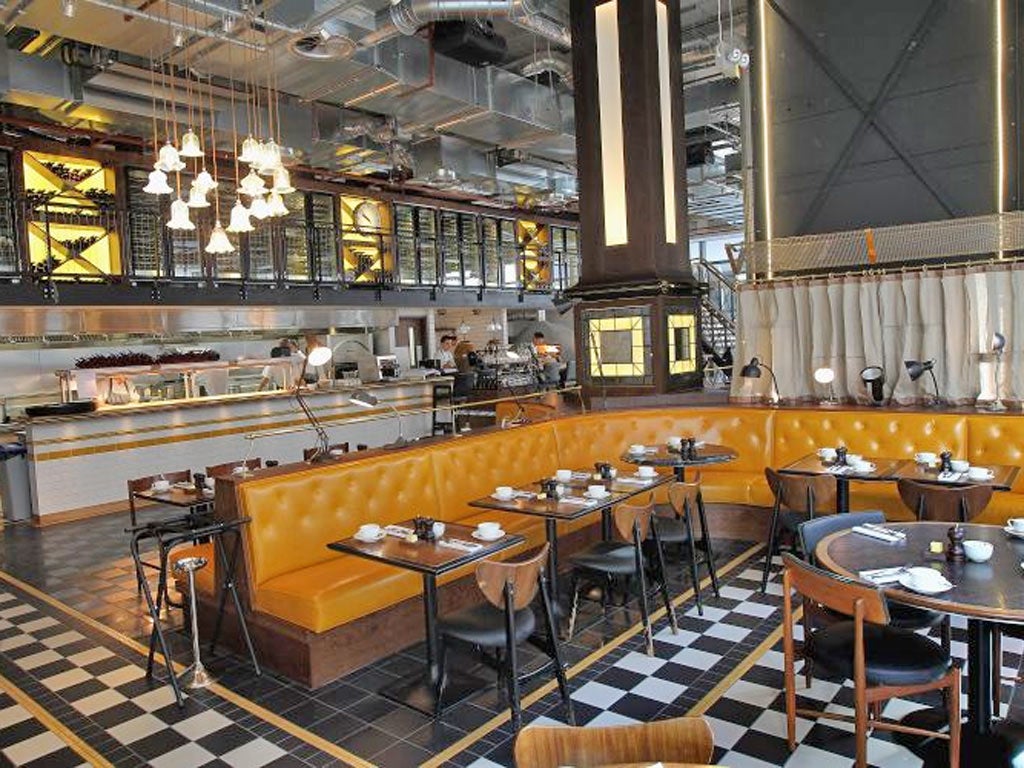Your table's ready: Interior design is as important as the cooking at a new generation of restaurants

You don't need to be a food critic to know that the restaurant experience is about far more than what's on your plate. And a spate of recent openings and relaunches suggest that delicious décor is a higher priority than ever for many restaurateurs.
In London, Gordon Ramsay's new Bread Street Kitchen has been winning plaudits as an Art Deco-style venue, with warehouse-height ceilings, checker-board flooring and vintage lamps, despite being in a brand new building.
With its marble, leather booths and vast light domes, the extravagant Victorian-meets-Roman design of Massimo's at the Corinthia Hotel is an obvious hint as to where a chunk of the £300m the owners spent restoring the hotel went.
Earlier this month the Jumeirah Carlton Tower hotel reopened The Rib Room restaurant, where carnivorous guests can admire the oak furniture against a landscape of green fittings from the marble-topped bar.
And it's not just a capital-centric trend: in 2013, restaurant group D&D will be opening two venues in Leeds to be designed by Conran and Partners, a firm known for eye-catching and extravagant designs such as Quaglino's and The Bluebird in London. The soon-to-be relaunched "Spiceal Street" in Birmingham's Bullring (which boasts a Handmade Burger Co and Thai restaurant ChaoBaby) looks like it is following the innovative food courts of the London Westfield centres (living green walls and water features at Westfield London, exposed steel, reclaimed wood and marble tops that scream industrial East End at the Stratford site).
Richard Harden, co-publisher of Harden's restaurant guides, says that as a nation, we have come a long way from the "stripped floors, white walls and halogen down-lighters" of 20 years ago. "People have looked long and hard at what they're trying to create," he says of the recent spate in expensive designs.
"There's no point in spending a couple of million quid on something nobody actually wants."
One of the results of this, he believes, is the loss of "all the old ideas about formality". Adding: "Nowadays the smarter the restaurant, the less likely it is to have a tablecloth. Many certainties have been turned on their heads."
Interior architect David Collins firmly believes in creating this sort of relaxed environment. But as the man responsible for the pitch-perfect classic-yet-modern designs of J Sheekey, The Wolseley and Massimo at the Corinthia (which won best new design at the recent Time Out Awards), he also knows how to create striking venues.
"I want any restaurant I get involved with to be fun, relaxing and not too formal," he says. "Every bit of a meal out is important – the surroundings, the company and the memories that you take away." What's also noticeable is that the demand for top design quality is no longer the preserve of high-end establishments. Martin Brudnizki is considered to be one of the industry's top interior designers, whose work can be seen at fashionable and exclusive joints such as Scott's, The Rib Room and the Soho House group. But recently he has also worked at Jamie's Italian and Nando's. When designing branches of Jamie's Italian, Brudnizki looked to create a space where every customer had something to look at beyond their dining companions.
"The kitchen is open to the restaurant, plus there's an antipasto station, a bar, the pasta-making station, all of these items are like theatres, distributed through the restaurant," he says.
"All the diners have something to look at. It's very exciting."
Theatre, in addition to seating arrangements and, most importantly, lighting, are the three things Brudnizki – who takes between six months and a year on each project – looks to when creating a restaurant. But whatever the price of the set menu, he believes it's important to create an environment and atmosphere that accompanies both the menu and the location.
"Today people are paying not only to go and eat something, they are paying for an experience," he says.
Brudnizki was the consultant for the redesign of Le Caprice, which coincided with the restaurant's birthday earlier this month. Bar a slightly more dramatic bar area, the (somewhat muted) Art Deco décor remains as monochrome predominates: from the black floor tiles to the white walls, to the monochrome photographs on the walls. The decision to maintain both style and layout was a deliberate move to keep customers happy. "To try to change the table arrangement would cause a riot," he says. "So we kept table places, but got new tables and new chairs"
Others, however, prefer constant reinvention.
Across the various floors and rooms of Sketch restaurant in London, classical design meets the future: guests can move from the Parlour with its eclectic collection of comfy armchairs to the futuristic dining room with its egg-shaped lavatory pods.
And the venue regularly updates its appearance and furnishings, as well as employing a full-time curator, Victoria Brooks, who organises a series of art shows each year.
The period details
With cool tiling, groovy mustard booths and a checkerboard floor, Gordon Ramsay's latest venture is all about Art Deco – despite its modern exterior
The tables
Many will miss its snowy embrace, but the white tablecloth is dead. Gastropub-inspired bare-naked tables have become the norm in chic restaurants
The lighting
For some interior designers, if the lights are right, then everything else follows. Think unusual vintage lamps, rather than identikit uplighters
Join our commenting forum
Join thought-provoking conversations, follow other Independent readers and see their replies
Comments